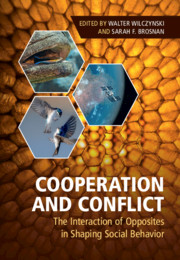Book contents
- Cooperation and Conflict
- Cooperation and Conflict
- Copyright page
- Dedication
- Contents
- Contributors
- Acknowledgments
- Introduction
- Part I Broad Insights from Political Science to Molecular Behavior
- Part II Neural Mechanisms
- Part III Species Comparisons
- 8 Understanding the Trade-off between Cooperation and Conflict in Avian Societies
- 9 Cooperation and Conflict in Mutualisms with a Special Emphasis on Marine Cleaning Interactions
- 10 The Fundamental Role of Aggression and Conflict in the Evolution and Organization of Social Groups
- Index
- References
9 - Cooperation and Conflict in Mutualisms with a Special Emphasis on Marine Cleaning Interactions
from Part III - Species Comparisons
Published online by Cambridge University Press: 08 February 2021
- Cooperation and Conflict
- Cooperation and Conflict
- Copyright page
- Dedication
- Contents
- Contributors
- Acknowledgments
- Introduction
- Part I Broad Insights from Political Science to Molecular Behavior
- Part II Neural Mechanisms
- Part III Species Comparisons
- 8 Understanding the Trade-off between Cooperation and Conflict in Avian Societies
- 9 Cooperation and Conflict in Mutualisms with a Special Emphasis on Marine Cleaning Interactions
- 10 The Fundamental Role of Aggression and Conflict in the Evolution and Organization of Social Groups
- Index
- References
Summary
Take any ecology textbook and look up the chapter on interactions between species, and you will find that ecologists distinguish among three outcomes: mutualism, commensalism and parasitism/predation. Mutualisms are mutually beneficial (+/+), commensalisms are beneficial for one partner and neutral for the other (+/0), and parasitism/predation is beneficial for one and detrimental for the other (+/−). Mutualisms are at the core of the world as we know it; the evolution of the eukaryotic cell warranted the mutualistic integration of cell organelles (mitochondria and chloroplasts) into prokaryotic cells, and the radiation of flowering plants as a nutritional basis for the animal food chain is dependent on soil microorganisms for the fixation of nitrogen and phosphate as well as on pollinators (Bronstein, 2015). Therefore, studying mutualism is an integral part of ecological research and one that connects directly to understanding the evolution of cooperation. (See Chapter 4 for a discussion of mutualisms at the cell and genomic levels.)
- Type
- Chapter
- Information
- Cooperation and ConflictThe Interaction of Opposites in Shaping Social Behavior, pp. 185 - 211Publisher: Cambridge University PressPrint publication year: 2021

